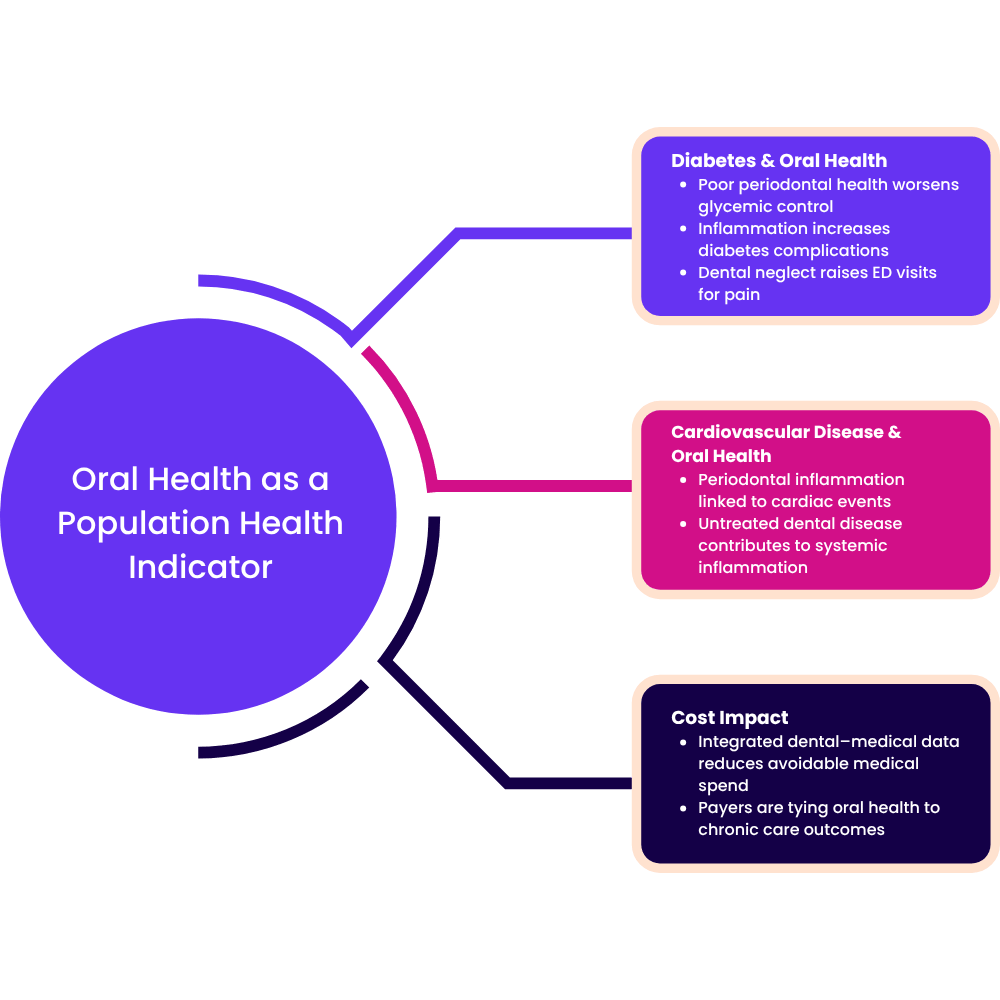Top 5 Reasons Dental Health Companies Must Embrace Population Analytics in 2026
For decades, dental health operated on its own island. Providers, payers, and platforms treated oral care as a parallel ecosystem rather than a core component of health. That separation is ending. In 2026, dental organizations will be pulled into population health, contracting, and care models. Ready or not.
The reason is this: the evidence linking oral health to conditions is overwhelming. Periodontal health affects diabetes complications. Inflammation from disease is tied to events. Dental neglect shows up in department visits. As claims become easier to integrate, payers are pushing for insights instead of encounters.
Population analytics is the bridge that will determine which platforms thrive in this environment. Here are the five reasons dental founders must move now:

1. Identifying Patients Earlier
Most risk is hiding. Patients with disease, visit patterns, or issues appear fine in settings. Population analytics changes that. By blending claims, lab values, signals, and indicators, platforms can flag members. Diabetics with A1c trends, patients with inflammation, or members visiting care for pain.
Identification allows for recalls, outreach, and interventions. In a world of value, this is no longer optional. It’s the cost of participating.
2. Closing Gaps That Drive Spend
Dental care gaps are no longer just metrics. They’re cost drivers. Gum disease increases inflammation, which raises the cost of diabetes and heart disease management. Visits correlate with encounters, prescriptions, and admissions.
Population analytics helps quantify these gaps at scale:
- Which patients are overdue for care?
- Which cohorts show the disconnect between dental and medicine?
- Which locations or providers fall behind in metrics?
Payers are asking dental partners to demonstrate their ability to close these gaps. Not just track them.
3. Meeting Reimbursement and Program Expectations
2026 marks a turning point for reimbursement. State programs are mandating reporting, metrics, and integration. Medicare plans are expanding benefits but demanding data in exchange. Payers are adding integration clauses in contracts.
Population analytics is the way to meet these expectations. Dental organizations must show:
- Populations
- Utilization trends and impact
- Compliance with metrics
- Outcomes that link dental care to savings
Without these capabilities, dental platforms will be sidelined during negotiations.
4. Enabling Care Models
The industry is moving toward teams where dentists, physicians, and specialists share responsibility for outcomes. That model doesn’t work without data and analytics.
Care requires:
- Histories that combine events
- Insights that highlight when oral health will impact disease progression
- Workflows that coordinate outreaches across teams
Dental organizations that can plug into ecosystems will become partners for systems and payers. Those without interoperability will remain isolated.
5. Avoiding Exclusion From Pathways
As payments expand into diabetes, health, kidney disease, and care, oral health is emerging as a touchpoint. If a dental company cannot provide data, track outcomes, or integrate into a bundle, it will not be included.
Being excluded means:
- Zero participation in dollars
- No access to networks
- Losing contracts to competitors with pipelines
Population analytics is the price of entry into these pathways.

The Imperative for 2026
Dental platforms that lack pipelines, stratification, and insights will struggle to scale or win contracts. The shift toward integration is not theory. It is reshaping criteria, selection, and models.
Dental innovators can seize this moment by investing in:
- Interoperability (claims, EHR, SDoH, exchange)
- Analytics (scoring, models, forecasting)
- Workflows (automation, management, tracking)
The winners in 2026 will be the dental organizations that stop thinking like practices and start operating like platforms. Oral health is now a lever in managing disease, reducing spend, and delivering care. And population analytics is the foundation that will make all of it possible.




